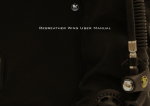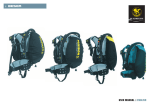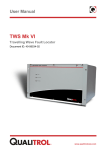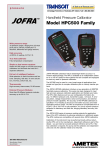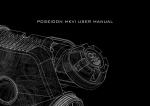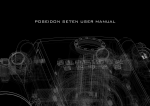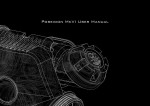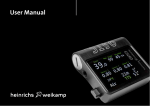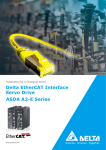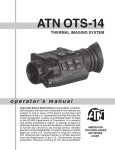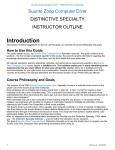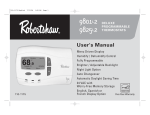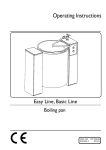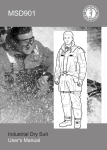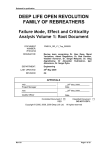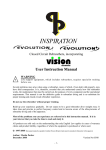Download Rebreather BCD User Manual
Transcript
Rebreather BCD User Manual Rebreather BCD User Manual Chapter 1 Page 1 The Rebreather BCD The rebreather BCD is the first of its kind and features include integrated exchangeable lungs, weight system and the Poseidon individual patch system. The rebreather BCD is constructed to the highest quality and durability using ballistic nylon*, YKK zippers and hand crafted detailing. Material Premium black version in Nylon 1680. 3 color versions in red, blue and grey made in Cordura 1000. YKK Waterproof Zippers. Inflator with stainless steel mechanism. Technical features Integrated Counter Lungs, Integrated weightpockets, case for crotch strap, velcro for patches or gauntlet. Approvals/Certifications The BCD are approved according to the EU Directive for Personal Protective Equipment, 89/686/EEC and meets or exceed the requirements of: EN 1809:1997. Type examination certificate number 6403 A/09/16 PSA (Revision 1) Issued by; DEKRA EXAM GmbH Persönliche Schutzausrüstungen, Gasmessgeräte Adlerstraße 29 * 45307 Essen Germany Notified body number 0158. Poseidon Diving Systems AB is certified according to ISO 9001 Text, photographs and figures copyright © 2008-2012 by Poseidon Diving Systems AB. ALL RIGHTS RESERVED. Manual Version 1.0 - February 2012. Rebreather BCD User Manual WARNING: Read user’s manual before use. This is not a lifejacket: it does not guarantee a head up position of the wearer at the surface. Safe use of this product requires instruction in buoyancy control from a certified instructor. Inspect all components of this product for proper operation, damage, wear or leakage before each use. Do not inhale gases from inside bladder. Rinse with fresh water thoroughly and drain after use. Store partially inflated. The information tag attached to the BCD (under the zipper next to the symbol) contains the above information and shall not be removed from the bladder. Diving is a strenuous physical activity. Its difficulty may be increased by conditions such as cold water, poor visibility, hard work, and increased depth. Always try to exercise prudent judgement when determining whether or not to dive. Never dive when tired or in poor health. Check that weights can be dropped off freely. If BCD integrated weights are not used, make absolutely sure the weight belt is not entangled when put on. If it is entangled it can be prevented from dropping off freely, and your emergency ascent can be jeopardised. Chapter 1 Page 2 WARNING: You must be familiar with the procedure to drop weights in case of an emergency ascent. Practice this procedure prior to your first use of your BCD in a perfectly safe environment, i.e. in confined water which is not deeper than 3 meters. Modifications of the product beyond what is described in this manual are prohibited. Modifications can impair the function of the BCD, and transfers the responsibility to the person who does the modification. Maximum load on any stainless steel D-rings is 1500 N, please refer to technical data/Manufacturers approval. Before use of the BCD in any configuration, you must have proper dive training and hold a certificate for diving from a recognised training organisation. As part of this training, you must have learnt how to establish neutral buoyancy, how to adjust the amount of ballast weights, safe descent and ascent techniques, inflating and deflating a BCD, donning and doffing both above and under the surface. With your new BCD you must practice these procedures again, and adjust the amount of ballast weights you may be used to. Retain this manual for your reference. Review this manual periodically, and prior to diving. Improper use, or misuse, of this harness or buoyancy compensator could result in serious injury or even death. Diving deeper than 50m the requirement of EN 1809 for time to completely inflate bladder will be exceeded. Rebreather BCD User Manual Functional Overview Chapter 1 Page 3 APRV Automatic Pressure Relief Valve. A valve which automatically prevents overpressurisation possibly harmful to the BCD. Often referred to as OPV (Over Pressure Valve) or dump-valve. The corresponding term in EN 1809:1997 is APRD (Automatic Pressure Relief Device). Right T-connection port Left T-connection port Integrated Counter Lung Integrated Counter Lung D-ring Adjustment Straps Welcro patch Counterlung Over Pressurization Valv (OPV) Chest Strap Information label (on the rear side of the back padding) Storage Pockets Adjustment Straps Zip for inner lung Manual inflation valve MDV Manual Deflation Valve. A manually operated valve which permits deflation of the BCD. This includes the APRV:s, the shoulder valve of the inflator when applicable, and the oral inflation/deflation button on the inflator. The corresponding term in EN 1809:1997 is MDD (Manual Deflation Device). Weight Pockets Adjustment Waist belt Storage Pockets Pocket for crotch strap Weight Pockets Rebreather BCD User Manual Chapter 1 Page 4 Assembly For Rebreather assembly, see separate manual. T-connections. Connect the T-connection to the port in each Integrated Counter Lung, (see chapter 1, T-section assembly in the main manual). APRV, most efficient water drainage position. Low Pressure hose. Connect the Low Pressure hose to a IP port on the diluent 1st stage. APRV QMR Adapter. Attach the cansiter housing to your BCD with the QMR Adapter. Rear CC loop hoses. Attach the rear breathing hoses to the left and right counterlung ports. Front CC hoses to counter lung T-section. Connect the left and right front CC loop hose to the counter lung T-connection. Rebreather BCD User Manual Chapter 1 Page 5 Donning Connect the quick connector of the inflator feed hose to the inflator mechanism. Undo waist belt buckle and crotch strap buckle. Put the BCD on starting with side where you have no instruments on your wrist, or APRV:s on your drysuit. Lean slightly forward and put the other arm into the BCD. Then tighten the waist belt, until you feel that you comfortably can carry the load. Finally, adjust the shoulder straps and buckle the waist belt, crotch strap and chest strap. Ensure you have adjusted the BCD size to fit perfectly. Put your weights into your weight pockets and lock the buckles. Pre Dive Checks Check that your BCD is free from visible damages, such as e.g. cuts, punctures, frayed seams, excessive abrasion, and loose/missing hardware. Open your cylinder valve. Check the correct operation of the inflator mechanism by pressing the inflation button to inflate the bladder, check for leakages, and then shortly press the deflation button. Check the manual deflation device mechanism by pulling the inflator corrugated hose. (does not apply to models with elbow connection to the bladder). Check that you can reach both APRV:s on the right and left side respectively. Pull the knob and make sure the correct operation of the APRV. Check that you can reach the handles of your QR weight system to release your own weights. If a crotch strap is used, check that it is locked and that is does not prevent the release of weights. Inflate the bladder sufficiently to keep you floating directly after entering the water. WARNING: Do not dive with a BCD that is damaged, leaks air, or does not function properly. Before each use inspect for proper operation, leakage, or damage. Terminate any dive as safely and quickly as possible if the BCD becomes damaged, leaks air, or does not function properly. Always perform a pre-dive and post-dive inspection of the BCD. Have your dive partner perform a crosscheck as well. The predive and post-dive BCD examinations help identify equipment problems before unsafe conditions exists. Ensure you are using a regulator set at min/max working IP = 8 – 9.5 bar. Make absolutely sure your weight system is not entangled, and can be dropped off freely. Rebreather BCD User Manual Chapter 1 Page 6 Diving WARNING: WARNING: Do not use your BCD as an assist or “lift bag” for bringing objects to the surface. These objects may be lost during the ascent, creating a sudden increase in buoyancy and loss of buoyancy control. Avoid attempting to deflate an already empty bladder as this will allow seawater to enter. A flooded BCD can cause buoyancy difficulties. Do not inhale gases from inside bladder. Keep sand and other contaminations out of the oral inflation mouthpiece and valve button. Under certain conditions contamination can cause the valve to not close completely. If this occurs while diving, shake the valve while operating it several times. If the valve leaks or remains inoperable immediately terminate the dive. Diving with a leaking BCD or with valves that do not operate properly may result in loss of buoyancy control that could result in serious injury or even death. Be aware that the mesh at the bottom of the wing needed for effective draining of water, do expose an increased risk for bladder puncture. Make sure to protect this from coming in contact with sharp objects. Buoyancy compensating is achieved by inflating and deflating the BCD bladder. Inflating the BCD using the power inflator is done by depressing the inflator button using short bursts. Continuous depressing of the button can cause you to become excessively buoyant. Orally inflating of the bladder is achieved by exhaling a small amount of air into the inflator. Place your lips on the inflator mouthpiece and exhale while depressing the oral inflation button. After exhaling release the oral inflation button to prevent air from escaping. Deflating the BCD is done by using either the inflator’s oral inflation button or any of the APRV:s. For deflation using the inflator oral inflation button, hold the inflator in an upright position so that it becomes the highest point of the BCD and depress the oral inflation button. Deflation of the BCD using an APRV is done by activating the valve that is placed on the highest portion of the BCD depending on the diver’s attitude during the actual period of time. The two APRV:s placed on the rear lower portion of the BCD are activated by pulling the knob. For activating the inflator integrated MDV pull the inflator as if to extend the corrugated hose. In case of inflator malfunction or freezing, the inflator might continuously inflate the bladder. Start by detaching the inflator hose and continuously deflate the bladder by depressing the oral inflation button while holding the inflator at the highest possible position to increase deflation effectiveness. After Dive After finishing your dive start with undoing your weight pockets. Let water out from your BCD that may have entered the bladder during your dive. It is important to open up the breathing loop to allow the hoses and other components to dry overnight. This is, by far, the best procedure for keeping theinside of the breathing loop clean. All four breathing hoses should be removed from their attachment points (mouthpiece, shoulderports, and main housing), and placed such that water inside will drain out, and somewhere with relatively dry, well-circulated air. It is good practice to rinse, disinfect, and dry the counterlungs after a dive. Any disinfectant solution that doesn’t have a negative effect on plastics and/or rubber can be used for this purpose. Poseidon recommends using a disinfectant called Gigasept™ or Virkon. Inflate the BCD, either orally or by using the inflator. With the BCD almost fully inflated, rotate it back and forth a few times so that the entrapped water collects inside. Then let the water out through the inflator, by holding the BCD up side down, with the inflator at the lowest point and depressing the oral inflation button. Rinse your BCD in fresh water both internally and externally after every dive. After seawater have been emptied as described above, fill approximately 1-2 litres of fresh water into the BCD via the inflator. Partly inflated, rinse the BCD internally and then let the water out as described above. Rebreather BCD User Manual Chapter 1 Maintenance Technical Data No other maintenance procedures that you can do yourself other than those described in section After Dive is needed. If your Besea is heavily contaminated and dirty, or after your last dive for the season, it is possible to wash the BCD in a washing machine. Valves and inside PU bladder shall NOT be washed in a washing machine. Unscrew all APRV:s and the inflator from the bladder. Unzip the bladder and remove the inside PU bladder. Tumble drying is prohibited. Always let your BCD dry completely before storage over a longer period of time. Water drainage; The most efficient way to drain water from the BC bladder is to use the top right shoulder port (refer to a pic). Always store the BCD partially inflated. Store in a place which is not exposed to extreme temperatures or direct sunlight. Do not rest heavy objects on the BCD. Expected lifetime for inside PU bladder is 10 years, but can vary depending on usage. Poseidon recommends replacing the bladder after maximum 10 years from the date of manufacture, or earlier depending on condition and usage. Avoid prolonged or repeated exposure to chlorinated water, such as in swimming pools. Wash your BCD immediately after any use in chlorinated water. Chlorinated water can oxidize fabrics and materials on your BCD, shortening its life, and cause colours to fade. Damage and fading from prolonged exposure to chlorinated water is specifically not covered under warranty. Maximum buoyancy Servicing It is extremely important for your safety that you keep your equipment in good condition. You need not carry out any other maintenance than described in previous section. The BCD should be inspected yearly by one of POSEIDON´s authorised service locations. Look for the POSEIDON Authorised Dealer sign. Inspection does not include a service overhaul, which only takes place if damages or malfunctions are discovered when inspected. If you are using BCD with gasses having elevated oxygen content (Nitrox), you must inform the servicing location about it. They will then always undertake a re-cleaning of the inflator and your inflator feed hose. Page 7 Temperatures Size Buoyancy XS 80 N - 20ºC to + 50ºC - 3ºC to + 40ºC S 90 N - 4ºF to + 122ºF + 27ºF to + 104ºF M 100 N L 110 N XL 140 N Working surface temp. Working water temp. All buoyancy figures reached within 5-8 seconds. WARNING: This BCD is only intended for use with the Poseidon MkVI rebreather with 2x3 liter cylinders. This is not a lifejacket: It does not guarantee a head up position of the wearer at the surface. Refer to the information label placed on the rear side of the back padding for further information.








